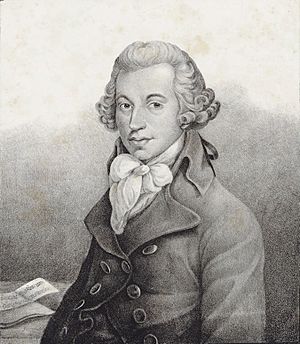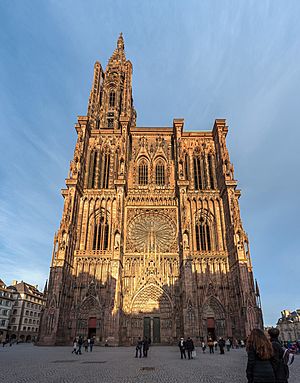Ignaz Pleyel facts for kids
Ignace Joseph Pleyel (born June 18, 1757 – died November 14, 1831) was a famous composer, music publisher, and piano maker. He was born in Austria but later became a French citizen. He lived during the Classical period of music.
Contents
Life of Ignace Pleyel
Early Years and Learning Music
Ignace Pleyel was born in Ruppersthal, a town in Austria. He was the eighth and last child from his father's first marriage. Later, his father had eight more children with his second wife.
When he was young, Pleyel likely studied music with Johann Baptist Wanhal. From 1772, he became a student of the famous composer Joseph Haydn in Eisenstadt. Pleyel was a very talented student, and Haydn thought highly of him. Like Beethoven, Pleyel received support from a rich noble, Count Ladislaus Erdődy, which helped him with his studies.
During his time as a student, Pleyel wrote a puppet opera called Die Fee Urgele (The Fairy Urgele). It was performed in a puppet theater. He also helped write part of the music for Haydn's opera Das abgebrannte Haus.
Pleyel's first job might have been as a music director for Count Erdődy. One of his first published works was a set of six string quartets. In the early 1780s, Pleyel traveled to Italy. There, he wrote an opera called Ifigenia in Aulide. He also composed music for the king of Naples, Ferdinand I.
Time in Strasbourg (1783–1795)
In 1783, Pleyel moved to Strasbourg, France. He became an organist at the Strasbourg Cathedral. This was a great place for him because the cathedral had a full orchestra, a choir, and a good budget for music. After moving to France, he started using the French version of his name, Ignace.
Pleyel wrote more music during his time in Strasbourg than at any other point in his career. He organized concerts at the cathedral, featuring his own symphonies and church music. When the main music director died in 1789, Pleyel took over the role. In 1788, he married Françoise-Gabrielle Lefebvre. They had four children, and their oldest son was Camille. Camille's future wife, Marie Pleyel, became a very skilled piano player.
In 1791, the French Revolution caused changes. Church music and public concerts were stopped. Pleyel then went to London to lead concerts there. It was interesting because his teacher, Haydn, was also leading concerts in London at the same time. Even though they were rivals in their work, they remained good friends.
Pleyel earned a lot of money from his trip to London. When he returned to Strasbourg, he bought a large house called the Château d'Ittenwiller.
During a difficult time in France called the Reign of Terror (1793–1794), life became dangerous for many people, including Pleyel. He was questioned several times because he was a foreigner, had bought a big house, and had worked at the cathedral. To show his loyalty to the new government, Pleyel wrote music celebrating the new republic. These pieces were:
- La Prise de Toulon (The Capture of Toulon)
- Hymne de Pleyel chanté au Temple de la Raison (Hymn sung in the Temple of Reason)
- Hymne à l'Être Suprême (Hymn to the Supreme Being)
- La Révolution du 10 août (The Revolution of August 10)
Most of these pieces were first performed at the Strasbourg Cathedral. Pleyel became a French citizen and was known as "Citizen Pleyel." He used his music to support the new government.
Pleyel as a Businessman
In 1795, Pleyel moved to Paris. In 1797, he started his own music publishing company called "Maison Pleyel." His company published many works, including all of Haydn's string quartets. They also created small music scores for students to study. His publishing business lasted for 39 years and released about 4,000 musical works. These included pieces by famous composers like Ludwig van Beethoven, Wolfgang Amadeus Mozart, and Muzio Clementi.
In 1805, Pleyel visited Vienna for business. He met his old teacher Haydn one last time and heard Beethoven play. In 1807, Pleyel also started making pianos. His piano company became very famous.
Later Years
Pleyel retired in 1824 and moved to the countryside outside Paris. He passed away in 1831. He knew that his style of music was becoming less popular as new Romantic music took over. He was buried in Père Lachaise Cemetery in Paris.
Pleyel's Music
Pleyel wrote a lot of music. He composed at least 42 symphonies, 70 string quartets, and several operas. Many of these works were written when he was in Strasbourg. After he became a businessman, he composed less.
Some experts now believe that the famous "Theme by Haydn" used by Johannes Brahms in his Variations on a Theme by Haydn was actually written by Pleyel, not Haydn. Pleyel also wrote music for masonic ceremonies.
Pleyel's Fame
Pleyel was incredibly famous during his lifetime, especially from about 1780 to 1800. However, he is not as well-known today as some other composers from his time. One writer said, "What composer ever created more of a craze than Pleyel? Who enjoyed a more universal reputation?"
His music was even popular in America. There was a Pleyel Society on an island called Nantucket. Pleyel's tunes were also used in popular American songbooks.
People liked Pleyel's music because it was often simple and easy to understand. A reviewer in London in 1791 said that Pleyel was becoming more popular than Haydn because his music was "less by the intricacies of science than the charm of simplicity and feeling." Today, Pleyel is still known for writing music that is great for students learning instruments like the violin and flute.
Pleyel Pianos and Salle Pleyel
The piano company Pleyel et Cie was started by Ignace Pleyel. His son, Camille, who was a talented piano player, joined the business in 1815 and continued it. The company made pianos that were used by the famous composer Frédéric Chopin. Chopin thought Pleyel pianos were the best.
The company also had a concert hall called the Salle Pleyel. Chopin performed his first and last concerts in Paris at this hall. In 2009, a copy of Pleyel's 1830 piano was made. It is now in a collection in Warsaw and is used for concerts and competitions.
Recordings
- Yuan Sheng. Frederic Chopin. Ballades Nos 1-4/Impromptus Nos 1-4. Played on the 1845 Pleyel piano. Label: Piano Classics
- Freddy Eichelberger. Beranger. Chansons. Pleyel 1845 piano. Early Piano series. CD 5. Label: Alpha Classics.
- Ronald Brautigam. Felix Mendelssohn. Piano Concertos. Played on a copy of the 1830 Pleyel piano made by Paul McNulty. Label: Bis
- Janusz Olejniczak Chopin evening around 1831 Pleyel.
- Alexei Lubimov. Chopin, Bach, Mozart, Beethoven: at Chopin’s home piano. Played on the original 1843 upright Pleyel piano. Label: NIFCCD
- Dina Yoffe. Fryderyk Chopin. Piano Concertos No 1 & 2. Version for one piano. Played on the 1848 Pleyel and the 1838 Erard pianos. Label: Fryderyk Chopin Institute
- Viviana Sofronitsky, Sergei Istomin. Frederyk Chopin. Complete works for cello and piano. Played on a copy of the 1830 Pleyel piano made in 2010 by Paul McNulty. Label: Passacaille
- Kevin Kenner. Fryderyk Chopin. 4 Impromptus. Played on the 1848 Pleyel piano. Label: Fryderyk Chopin Institute
- Patrick Schneyder. Franz Liszt. Mazeppa. Early piano series. CD 10. Played on Pleyel piano 1846. Label: Alpha Classics.
- Arthur Schoonderwoerd. Fryderyk Chopin. Mazurkas, Valses & other dances. Early Piano series. CD 7. Played on Pleyel piano 1836. Label: Alpha Classics.
- Tomasz Ritter. Fryderyk Chopin. Sonata in B Minor, Ballade in F minor, Polonaises, Mazurkas. Karol Kurpinski. Polonaise in D minor. Played on the 1842 Pleyel piano, the 1837 Erard piano and a copy of Buchholtz piano from ca 1825-1826 made by Paul McNulty. Label: Fryderyk Chopin Institute
See also
 In Spanish: Ignace Joseph Pleyel para niños
In Spanish: Ignace Joseph Pleyel para niños




